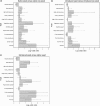How weeds emerge: a taxonomic and trait-based examination using United States data
- PMID: 24494694
- PMCID: PMC4235316
- DOI: 10.1111/nph.12698
How weeds emerge: a taxonomic and trait-based examination using United States data
Abstract
Weeds can cause great economic and ecological harm to ecosystems. Despite their importance, comparisons of the taxonomy and traits of successful weeds often focus on a few specific comparisons - for example, introduced versus native weeds. We used publicly available inventories of US plant species to make comprehensive comparisons of the factors that underlie weediness. We quantitatively examined taxonomy to determine if certain genera are overrepresented by introduced, weedy or herbicide-resistant species, and we compared phenotypic traits of weeds to those of nonweeds, whether introduced or native. We uncovered genera that have more weeds and introduced species than expected by chance and plant families that have more herbicide-resistant species than expected by chance. Certain traits, generally related to fast reproduction, were more likely to be associated with weedy plants regardless of species' origins. We also found stress tolerance traits associated with either native or introduced weeds compared with native or introduced nonweeds. Weeds and introduced species have significantly smaller genomes than nonweeds and native species. These results support trends for weedy plants reported from other floras, suggest that native and introduced weeds have different stress adaptations, and provide a comprehensive survey of trends across weeds within the USA.
Keywords: herbicide resistance; introduced plant; taxonomic selectivity; weed.
© 2014 The Authors. New Phytologist © 2014 New Phytologist Trust.
Figures





References
-
- Andersen UV. Comparison of dispersal strategies of alien and native species in the Danish flora. In: Pyšek P, Prach K, Rejmánek M, Wade M, editors. Plant invasions: general aspects and special problems. Amsterdam, the Netherlands: SPB Academic; 1995. pp. 61–70.
-
- Baker HG. Characteristics and modes of origin of weeds. New York, NY, USA: Academic Press; 1965.
-
- Barrett S. Genetics of weed invasions. Dordrecht, the Netherlands: Kluwer Academic Press; 1992.
-
- Bennett MD. Variation in genomic form in plants and its ecological implications. New Phytologist. 1987;106:177–200.
-
- Bennett PM, Owens IPF. Variation in extinction risk among birds: chance or evolutionary predisposition? Proceedings of the Royal Society, London Series B. Biological Sciences. 1997;264:401–408.
Publication types
MeSH terms
LinkOut - more resources
Full Text Sources
Other Literature Sources

